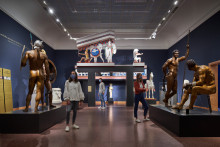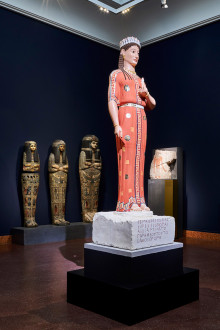Gallo-Roman Museum in Tongeren, Belgium (October 2023 to June 2024)
The Metropolitan Museum of Art, New York City, USA (July 2022 to March 2023)
Liebieghaus Skulpturensammlung, Frankfurt on the Main (January 2020 to September 2021)
Legion of Honor, San Francisco, USA (October 2017 to January 2018)
Museo del Palacio de Bellas Artes, Mexico City, Mexico (October 2016 to January 2017)
The British Museum, London, Great Britain (March to June 2015)
Ashmolean Museum, Cast Collection, Oxford, Great Britain (January to June 2015)
Ny Carlsberg Glyptotek, Copenhagen, Denmark (September to December 2014)
Museum der Universität Tübingen, Schloss Hohentübingen, Germany (April to August 2014)
Kunsthistorisches Museum, Vienna, Austria (November 2012 to March 2013)
Art collections of Ruhr University Bochum, Bochum, Germany (June to October 2012)
Winckelmann-Museum, Stendal, Germany (December 2011 to April 2012)
Heidelberg University, Institute for Classical Archaeology/University Collections, Heidelberg, Germany (October 2011 to May 2012)
University of Göttingen, Department of Archaeology/University Collections, Göttingen, Germany (March to July 2011)
Medelhavsmuseet, Stockholm, Sweden (October 2010 to January 2011)
Pergamon Museum, Berlin State Museums, Berlin, Germany (July to October 2010)
Museo Arqueológico Regional de la comunidad de Madrid, Spain (December 2009 to April 2010)
Museum Palace Wilhelmshöhe Collection of Antiques, Kassel, Germany (March to June 2009)
Liebieghaus Skulpturensammlung, Frankfurt on the Main (October 2008 to February 2009)
Museum für Abgüsse Klassischer Bildwerke, Munich, Germany (June to August 2008)
The Getty Villa, Malibu (Los Angeles), USA (March to June 2008)
Harvard Art Museums, Arthur M. Sackler Museum, Havard University, Cambridge (Massachusetts), USA (September 2007 to January 2008)
Museum of Arts and Crafts, Hamburg, Germany (April to July 2007)
Istanbul Archaeology Museum, Istanbul, Turkey (April to July 2006)
National Archaeological Museum, Athen, Greece (January to March 2006)
Allard Pierson Museum, Amsterdam, The Netherlands (August to November 2005)
Antikenmuseum und Sammlung Ludwig, Basel, Switzerland (August to November 2005)
Vatican Museums, Rome, Italy (November 2004 to January 2005)
Ny Carlsberg Glyptotek, Copenhagen, Denmark (March to May 2004)
Staatliche Antikensammlungen und Glyptothek, Munich, Germany (December 2003 to February 2004)








